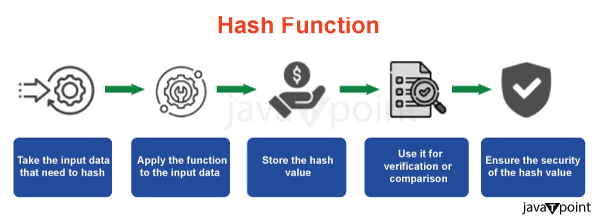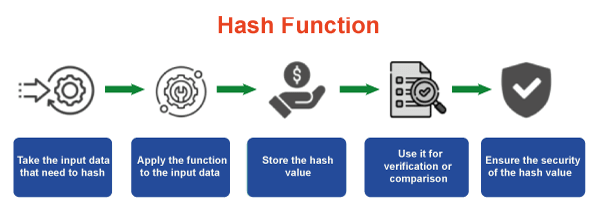Hashing and its ApplicationsData of any size can be mapped to fixed-size values using the hashing approach in data structures to facilitate fast access to or retrieval of the data. Using a hash function, the procedure converts the input data into a fixed-length character string (usually a hash code). The data in a data structure, such as an array or hash table, is then accessible using this hash code as an index or key. 
The Benefits of Hashing:1. Quick Data Retrieval: For data retrieval, hashing enables constant-time average complexity. Once generated, the hash code corresponds directly to the position of the data in the hash table, making access quick. 2. Effective Searching: Because it gives a direct mapping from the key to the index in the hash table, hashing is very beneficial for searching operations, resulting in speedy and efficient searches. 3. Storage requirements are reduced: Compared to other data structures, hashing might result in lower storage needs. The hash code is usually fixed in size, which might be beneficial in terms of memory utilization. 4. Perfect for Key-Value Stores: Hashing is a typical technique in key-value storage, where each key is hashed to get an index for the related value. This makes storing and retrieving key-value pairs more efficient. 5. Caching is encouraged: Hashing is frequently used in caching systems to rapidly determine if a specific data item is in the cache. This can dramatically increase application speed by removing unnecessary computations. 6. Uneven Distribution: A good hash function seeks to distribute keys equally over the hash table, avoiding collisions and maximizing storage space use. The disadvantagesThe disadvantages of hashing are as follows: 1. Collision Avoidance: When two separate inputs create the same hash code, this is called a collision. Proper collision resolution techniques, such as chaining or open addressing, are necessary, increasing the implementation's complexity. 2. Hash Function Quality Sensitive: Hashing efficiency is strongly reliant on the quality of the hash function. A poorly constructed hash function may cause more collisions, lowering speed. 3. Range Queries are not appropriate: Hashing is unsuitable for range queries or actions requiring sequential access to keys. Such processes may be less efficient since the hash function does not guarantee ordering. 4. Hash Codes with a Limited Range: The hash codes are usually of predetermined length, which limits the range of potential hash values. Collisions become more common when the number of possible keys exceeds the scope of hash codes. Hashing Applications:1. Databases: In database indexing, hashing is extensively used to rapidly identify records based on fundamental values, boosting the efficiency of data retrieval processes. 2. Caching: In caching systems, hashing is used to detect whether a particular item is present in the cache, hence avoiding repeated calculations and improving overall system efficiency. 3. Security: Hash functions are critical in cryptography because they generate hash values (hash codes) that reflect data integrity. Hashing is used to improve security in digital signatures and password storage. 4. Systems that are distributed: Hashing is used in distributed systems to balance load. Hash codes help determine which node in a distributed system should be responsible for storing or processing a particular piece of data. 5. Compiler Symbol Tables: Compilers utilize symbol tables to store identifiers (such as variable names) and their associated characteristics. Hashing is frequently used to create efficient symbol tables for speedy lookups. 6. Compiler Symbol Tables: Compilers store identifiers (such as variable names) and their related information in symbol tables. Hashing is frequently used to create efficient symbol tables that allow for speedy lookups during compilation. 7. DHTs (Distributed Hash Tables): DHTs distribute key-value pairs over a network of nodes via hashing. This is prevalent in peer-to-peer systems, where each node manages a subset of the keyspace. 8. Routing on the network: Some network routing techniques use hashing to spread traffic over various pathways. This may result in more equitable consumption of network resources. ConceptHashing converts incoming data (sometimes of indeterminate quantity) into a fixed-length string of characters, frequently a hash code. This hash code is then used as an index or key in a data structure like a hash table to store or retrieve data. The method involves several essential steps: i) The Hash Function--A hash function accepts a parameter, or key, and generates a hash code that consists of a fixed-length string of characters, using an exact manner. --The hash function ought to be deterministic, which implies that it should always return an identical encrypted code for the same input. --To avoid crashes, a good hash function divides inputs evenly over possible hash codes. ii) Hash Code:-The hash code is the hash function's output. This code is a fixed-size representation of the supplied data. -Hash codes are generally numeric or alphanumeric strings. For example, the hash code for the text "hello" may be "5df2a1." iii) Hash Table:--A hash table is an information format that keeps and retrieves data using hash values as indexes. ---It is frequently utilized as an array of values, with every array index equating to a distinct hash code. -The data record associated with a key is stored in the array at the index given by the hash code. iv) Data Storage:-The hash function is applied to the key to produce its hash code to save data in the hash table. -The data record is subsequently inserted in the hash table at the position specified by the hash code. -If collisions (two distinct keys yield the same hash code), collision resolution procedures (such as chaining or open addressing) are used. v) Data Retrieval:-To get the information, the algorithm for hashing is added to the key being used again to produce the hash code. -The encrypted code is applied to determine where the information in the record needs to be placed within the hash table of the form. -The appropriate collision resolution procedure is employed to locate the proper data record if there are any collisions. Hashing FunctionA hashing function is a critical component of the hashing concept. It begins with a parameter (or "key") and outputs a string with a fixed number of letters referred to as its hash code or value. The primary purpose of an encryption function is to swiftly and cheaply map input to a location in a structure of data, typically a hash table. 
Here are some hashing function features and considerations: 1. Deterministic: A hashing function should be deterministic, meaning it always outputs the same hash code for a given input. This feature guarantees that the mapping process is consistent. 2. Fixed Output Dimensions: A hashing function produces a fixed-size output regardless of the input data size. This fixed-size output is critical for sustaining stability. 3. Compute Efficient: To provide rapid data processing, hash algorithms should be computationally efficient. This is especially useful for applications that require quick data retrieval. 4. uniform Distribution: A good hashing algorithm strives to distribute input data equally throughout the potential hash codes. This helps to reduce collisions, which occur when separate inputs generate the same hash code. 5. The Snowball Effect: A valuable characteristic of hashing algorithms is the avalanche effect. A slight change in the input data should result in a considerably different hash code. This characteristic increases the hash function's security and dependability. 6. Collision Resistance: While avoiding collisions altogether is not always feasible, a hashing algorithm should avoid causing crashes for various inputs. Collision resistance is significant in cryptography applications. 7. Reversible (in Certain Applications): In some applications, such as data encryption, the hash function should be irreversible (one-way). In contrast, because the original data is saved with the hash code, it is not essential to reverse the procedure for hash tables. ConclusionIn conclusion, hashing is a diverse and robust topic in computer science with several applications in various disciplines. The core principle of translating data into fixed-size hash codes using hash functions provides for efficient data storage, retrieval, and security. In essence, hashing is a fundamental notion that solves the requirement for efficient data structure, retrieval, and security in various computing activities. Selecting an appropriate hash function and collision resolution approach is crucial to the efficacy of hashing in specific applications. As technology advances, the importance of hashing grows, making it a necessary component of contemporary computing.
Next TopicIslands in a graph using BFS
|
 For Videos Join Our Youtube Channel: Join Now
For Videos Join Our Youtube Channel: Join Now
Feedback
- Send your Feedback to [email protected]
Help Others, Please Share









